
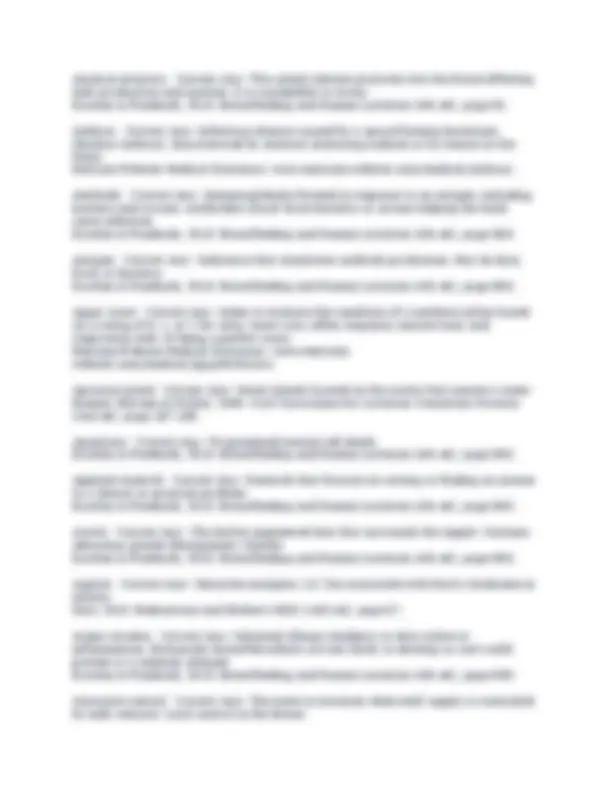
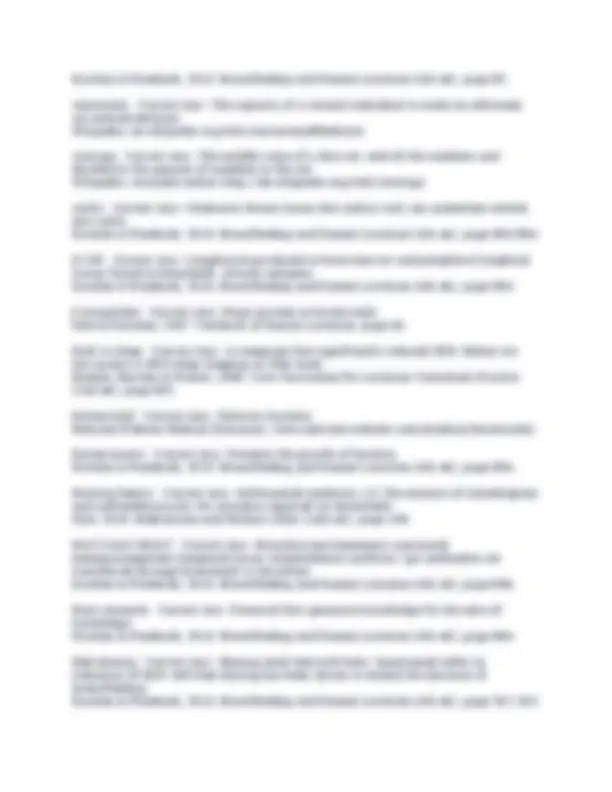

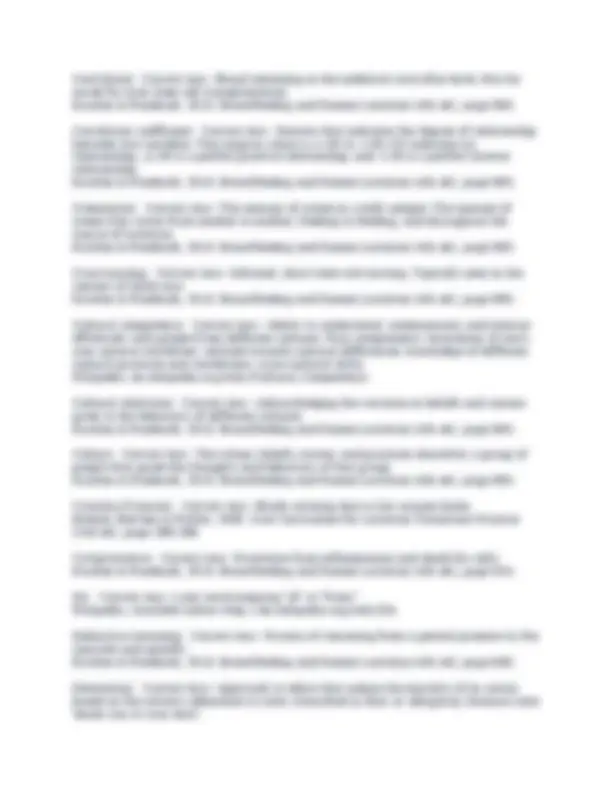
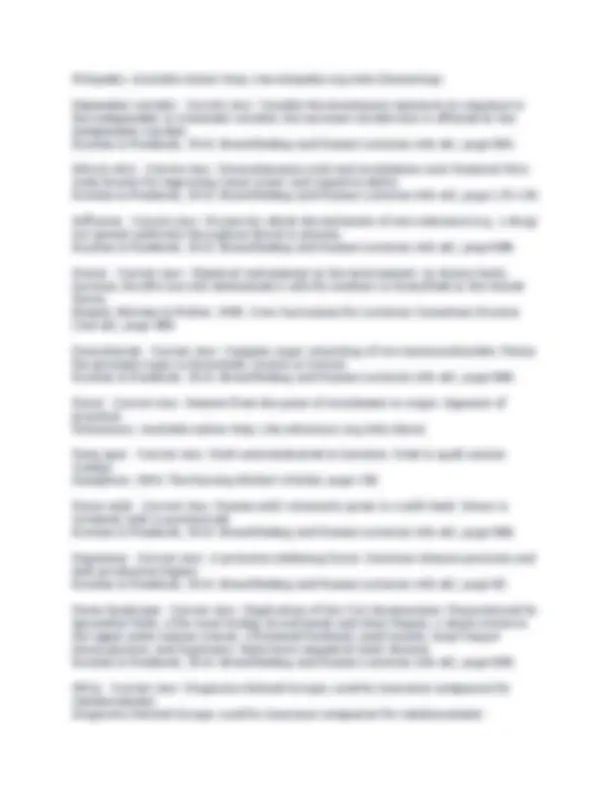
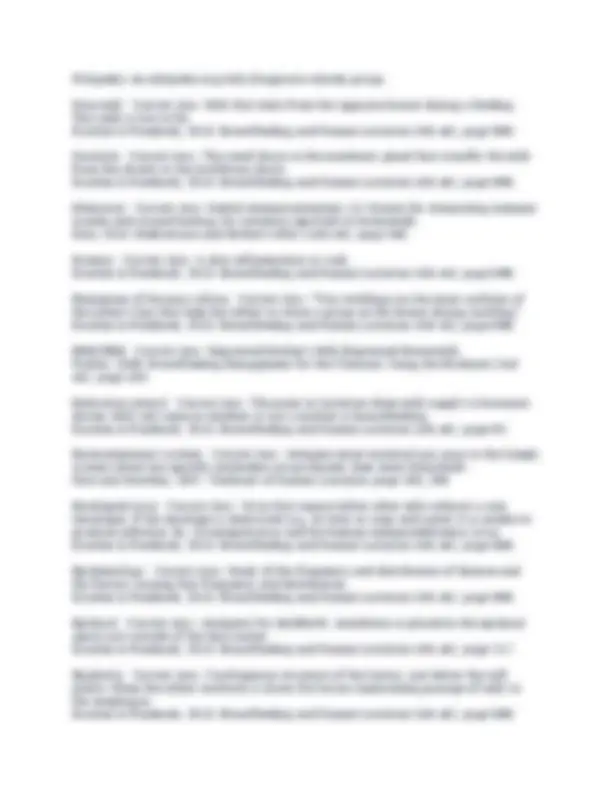
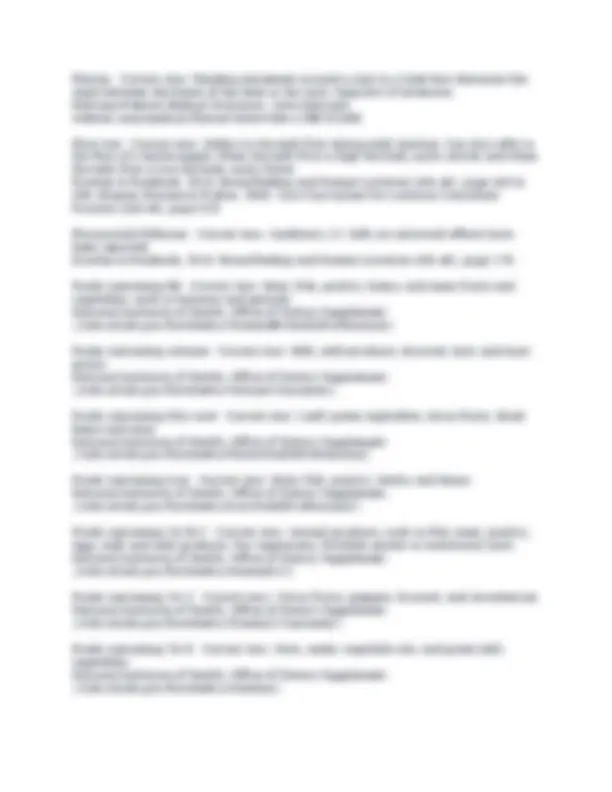
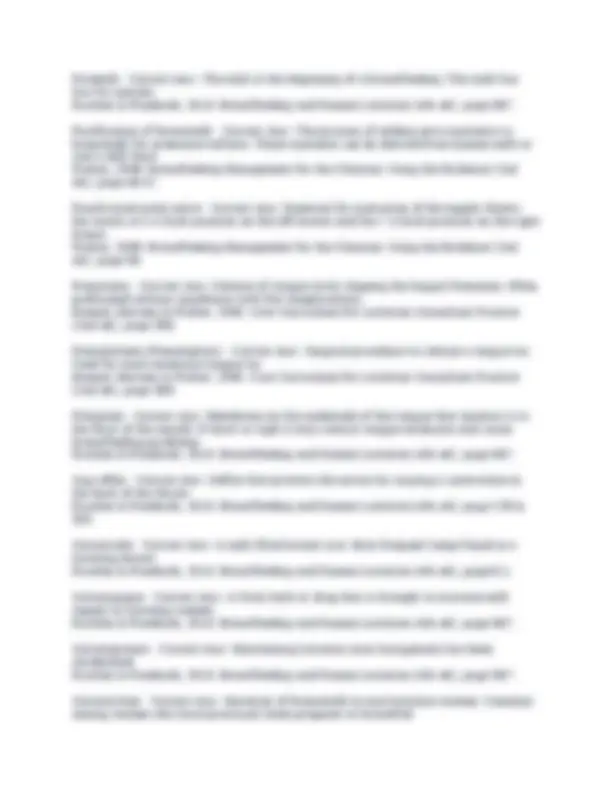
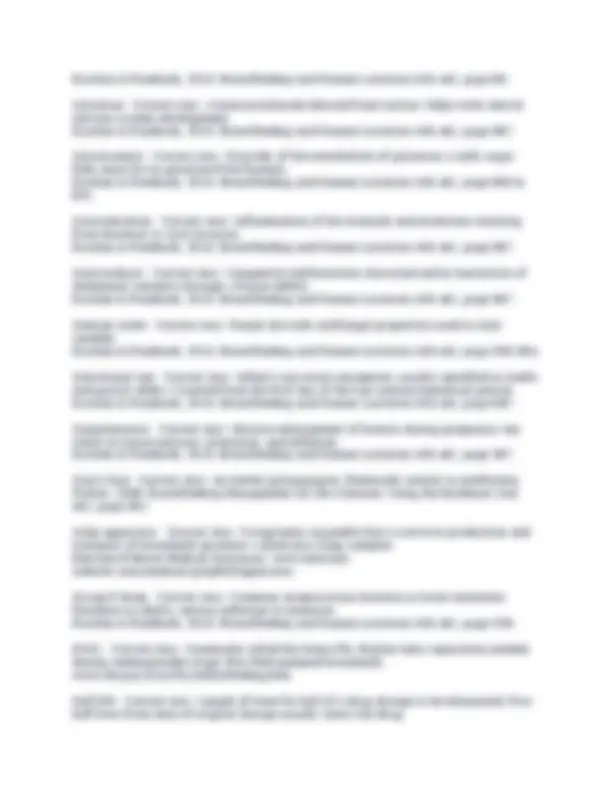
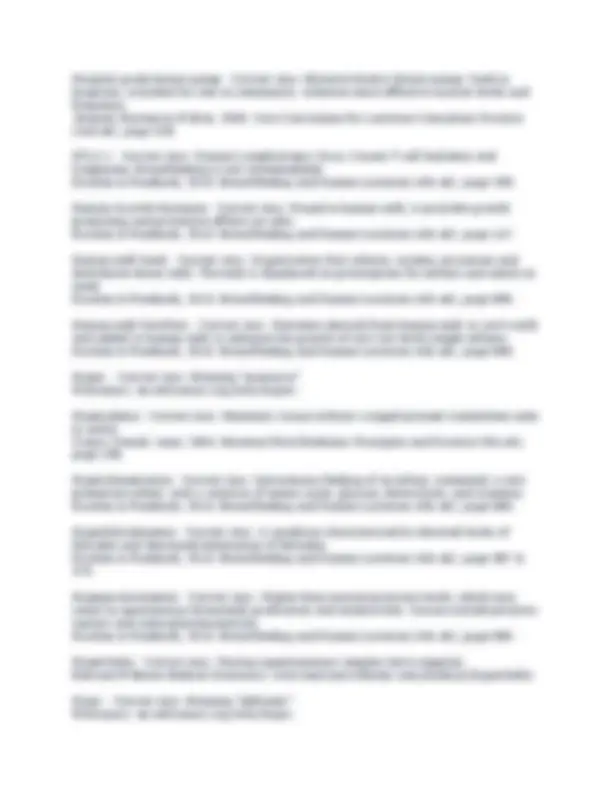
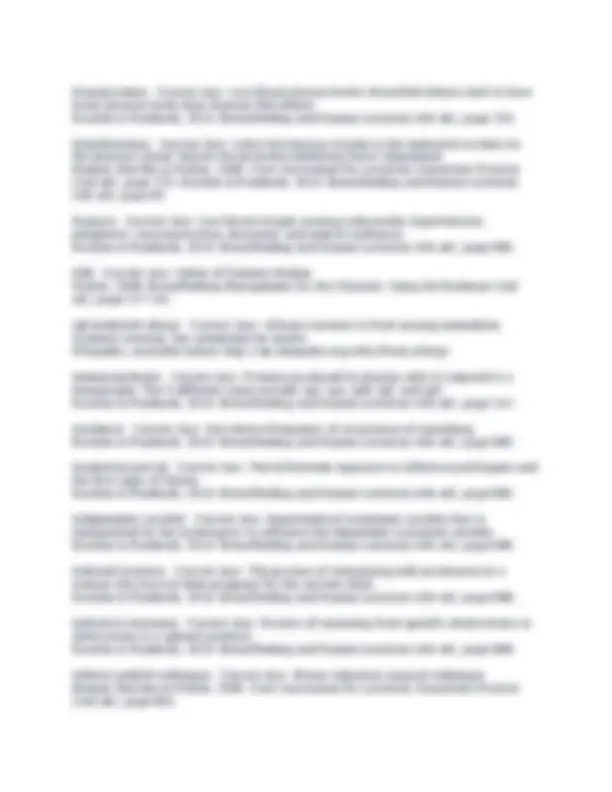
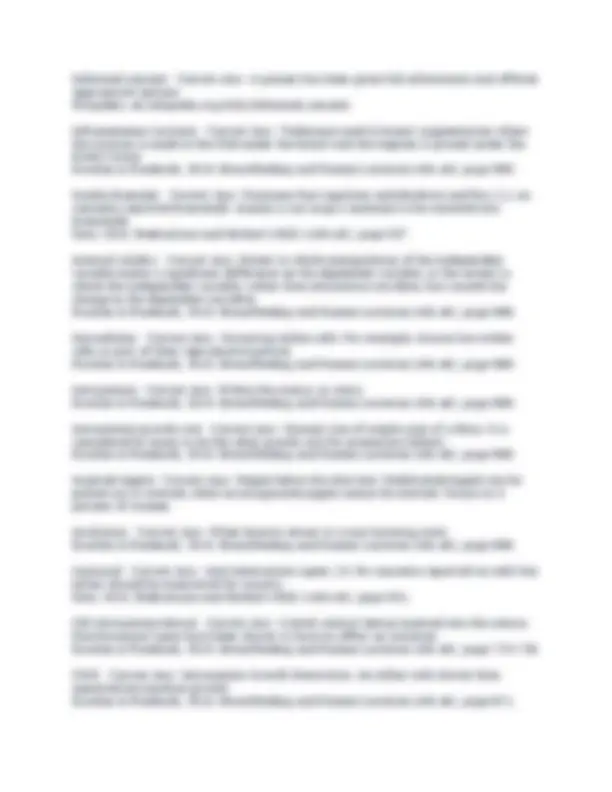
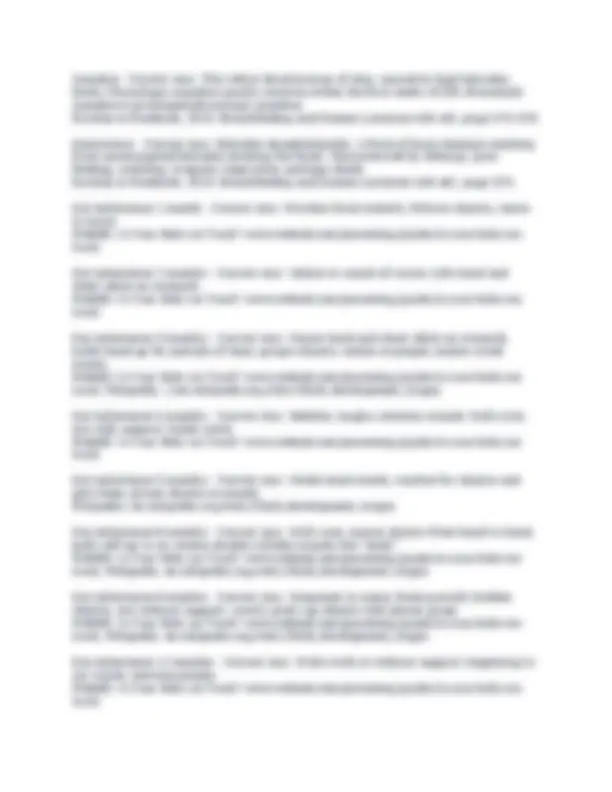
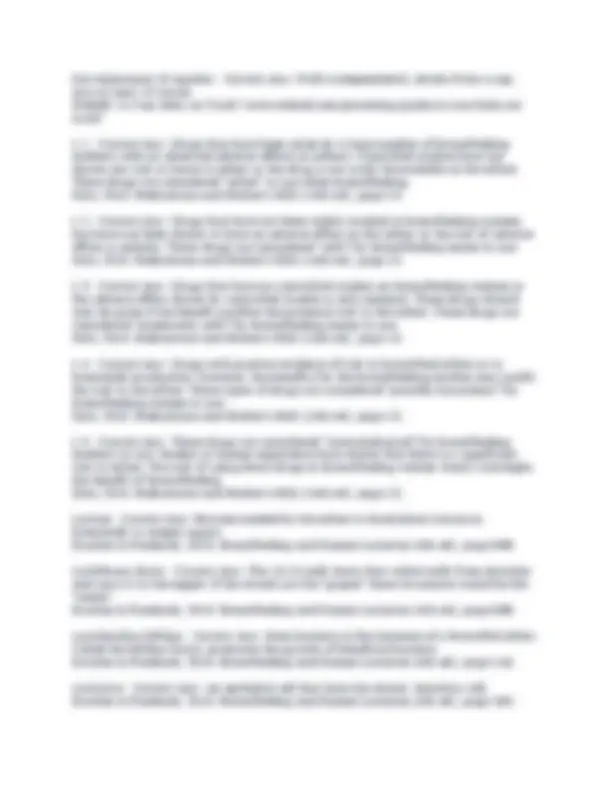
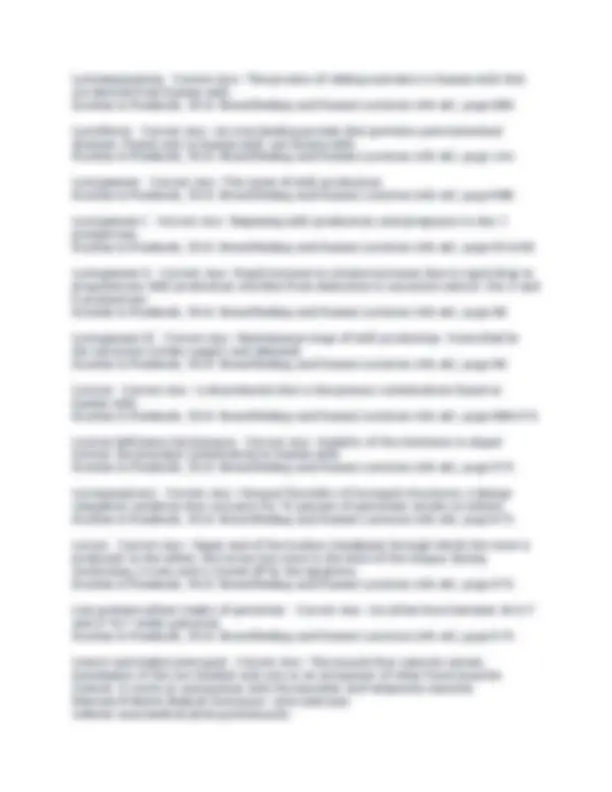
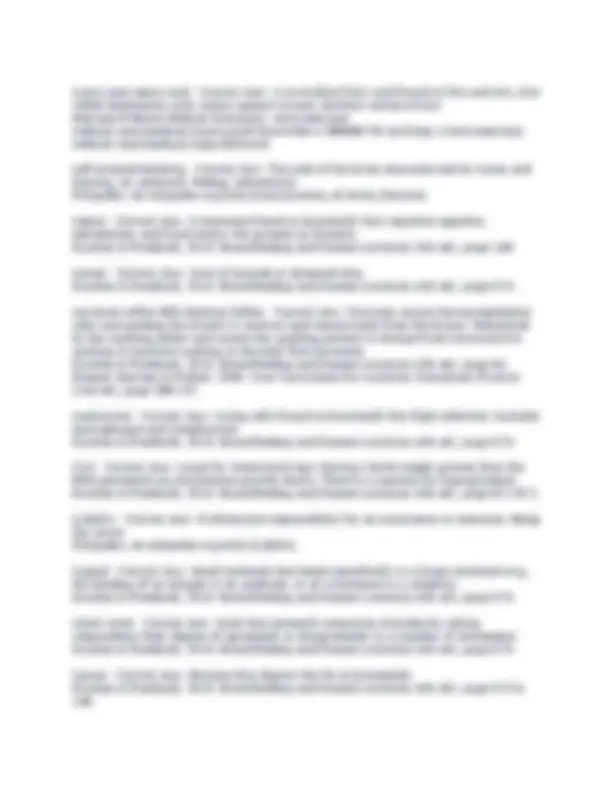
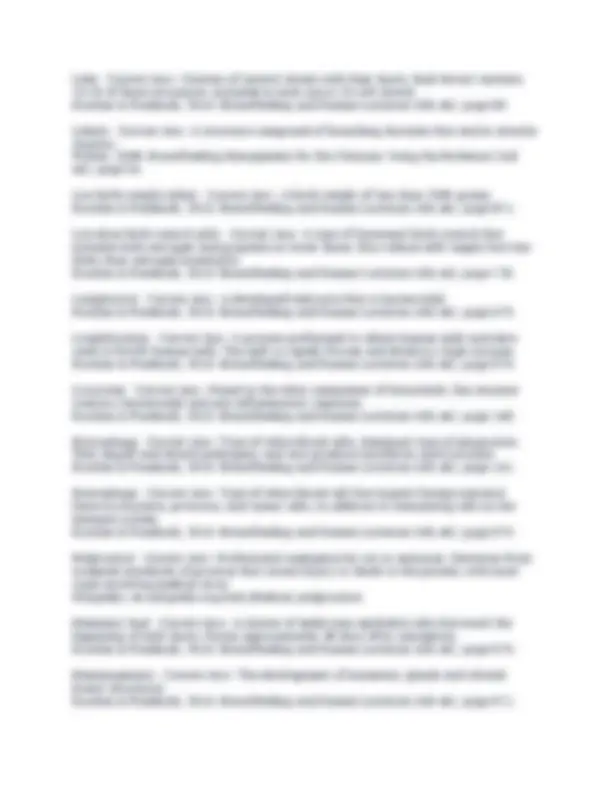
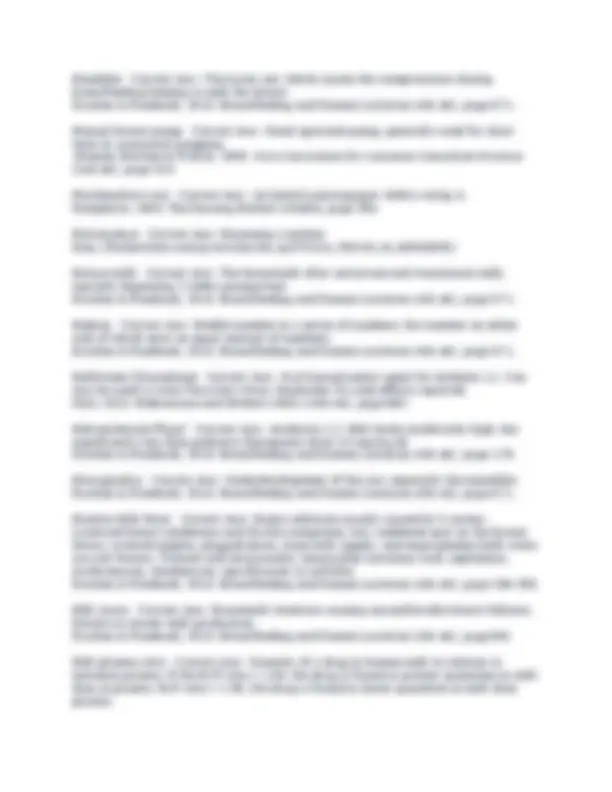
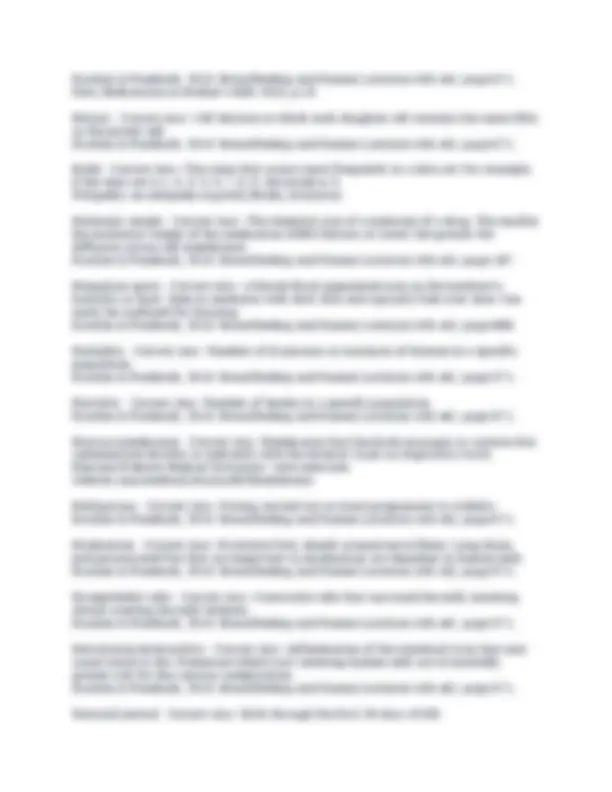
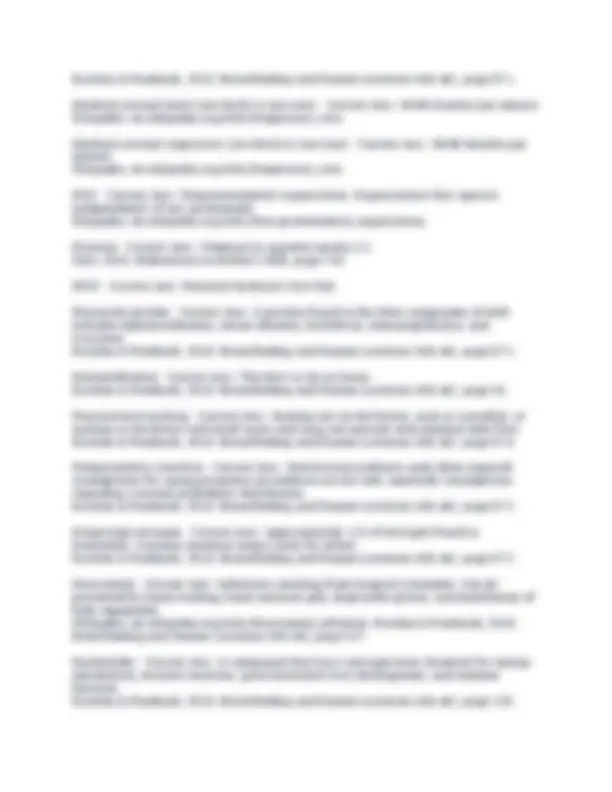
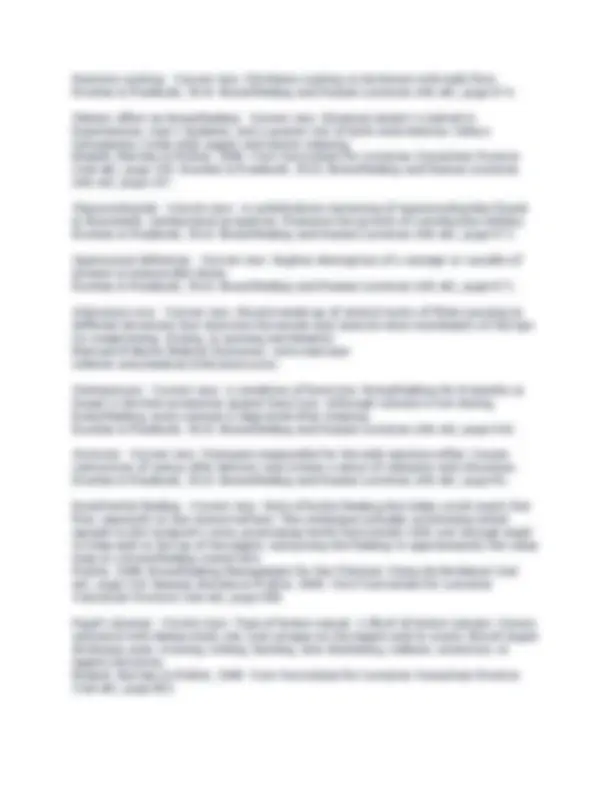
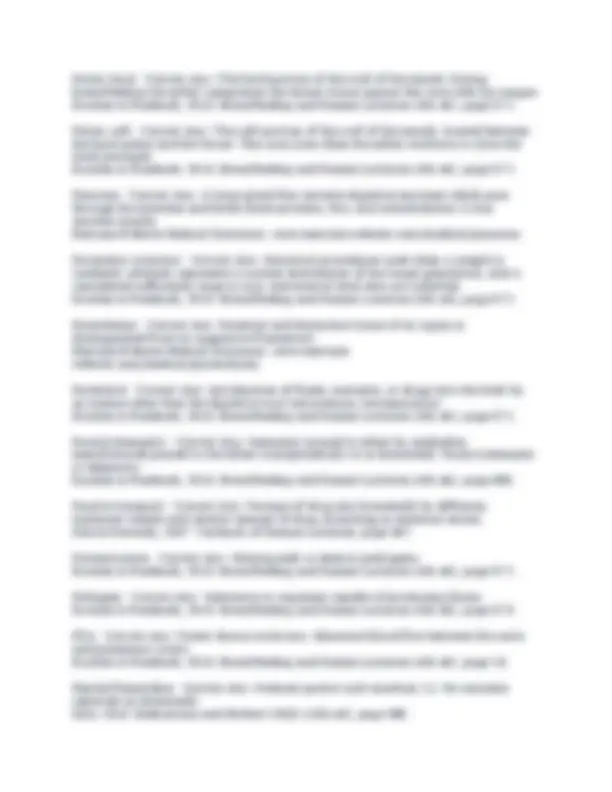
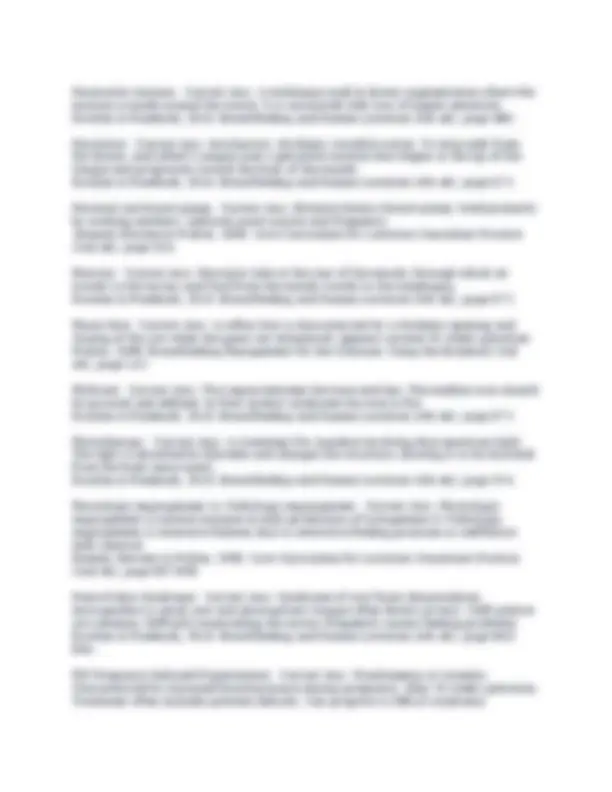
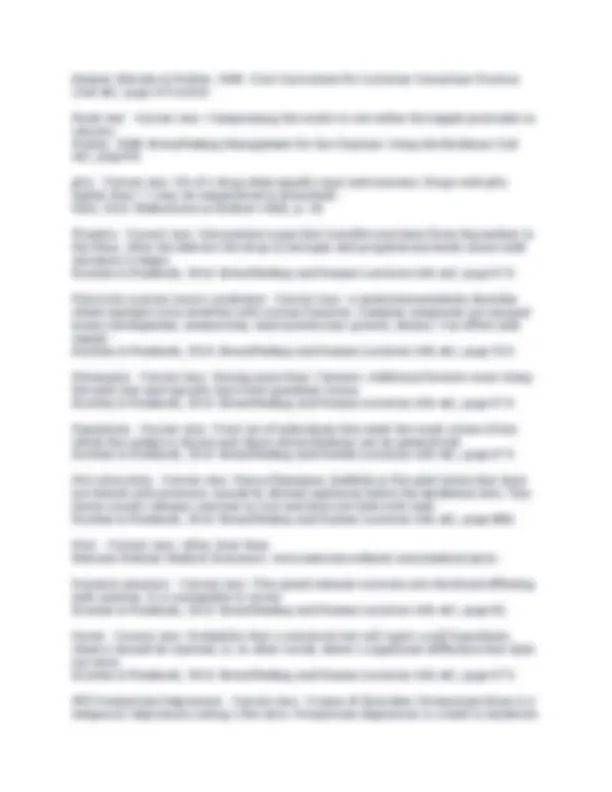
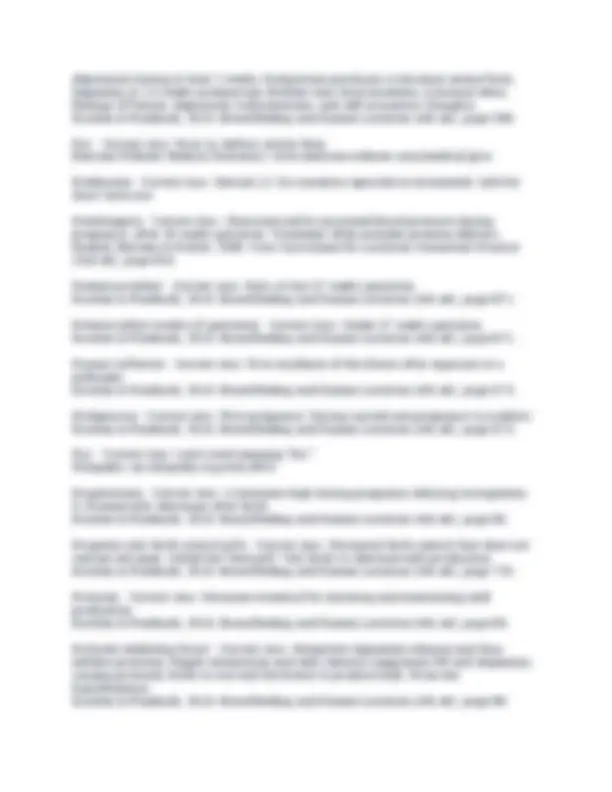
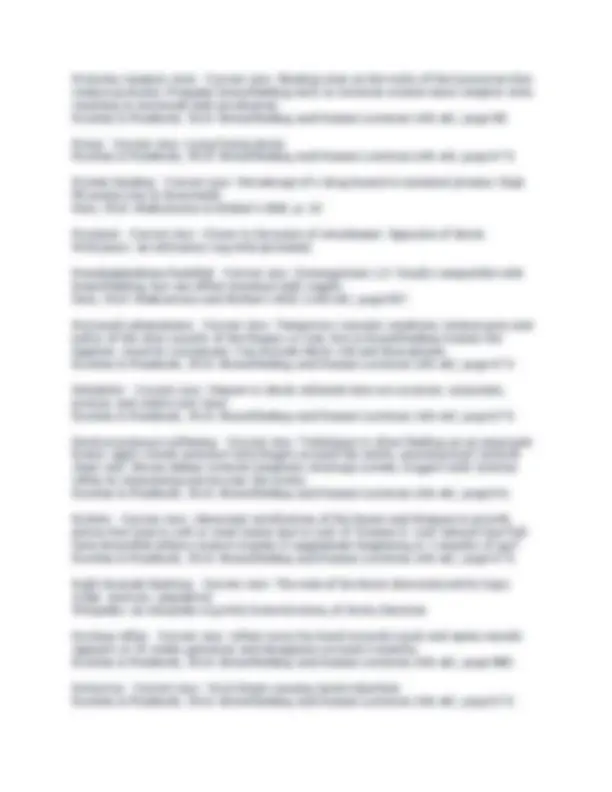
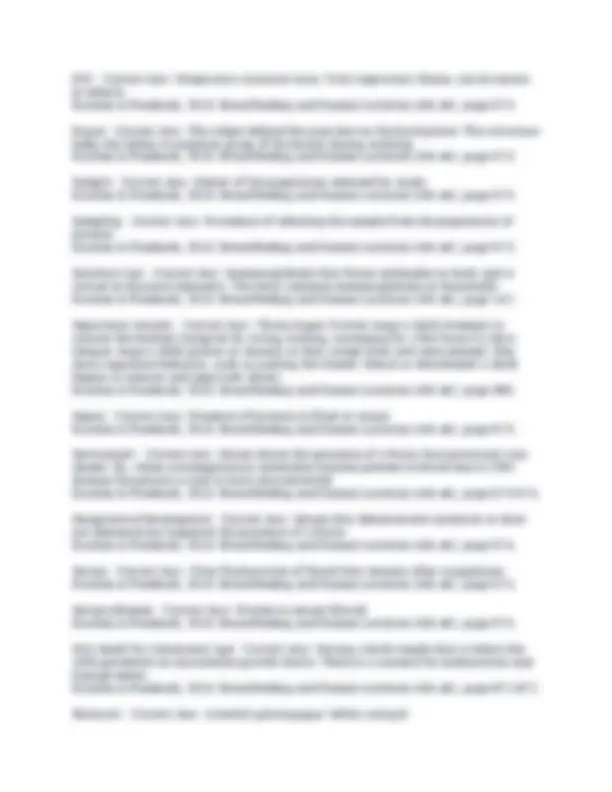
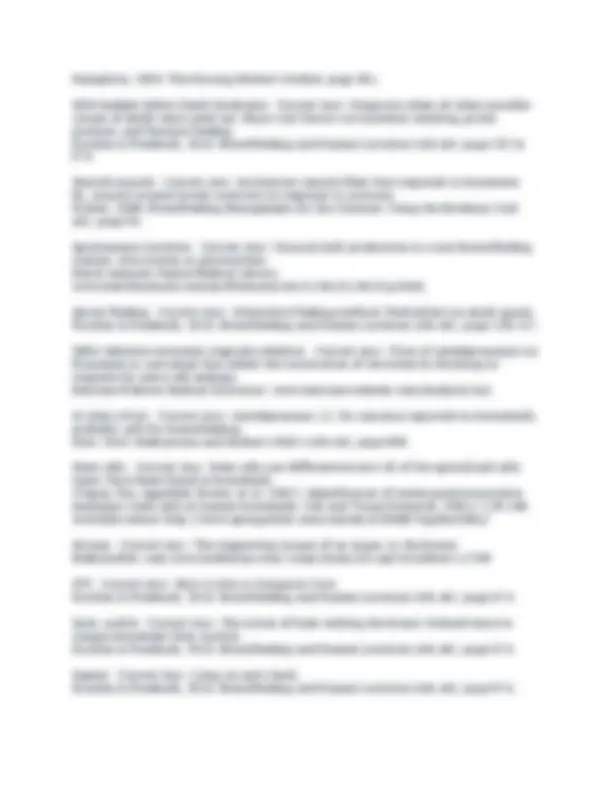
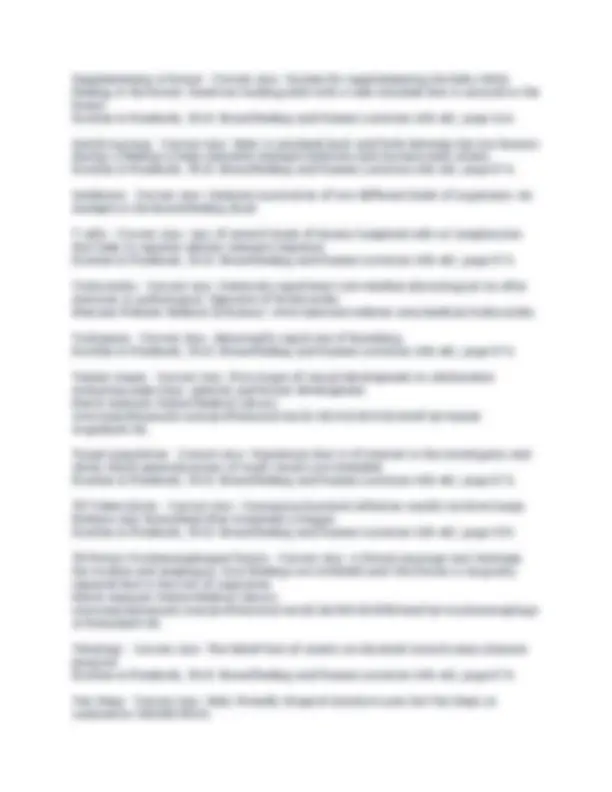
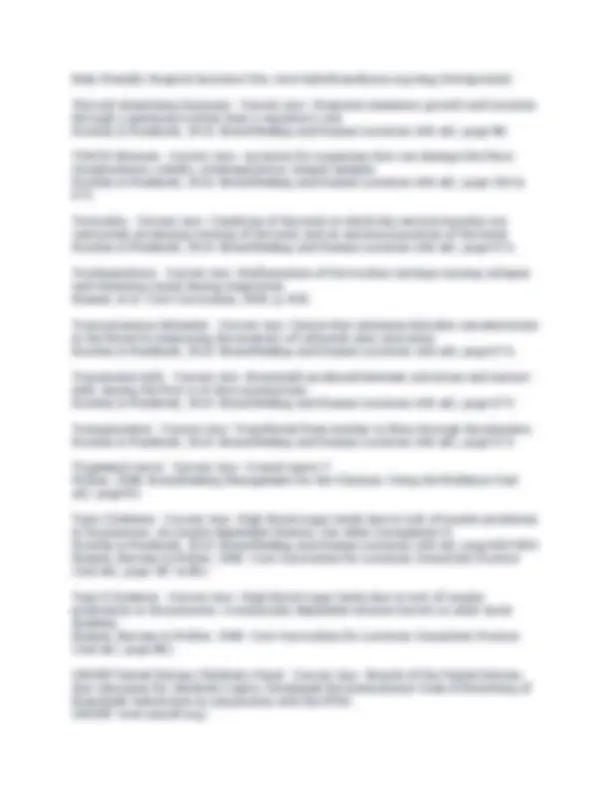
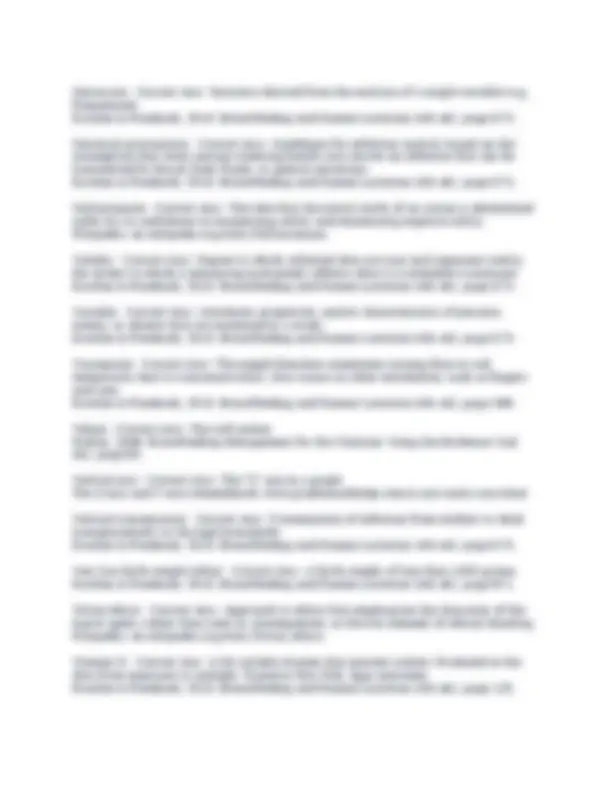
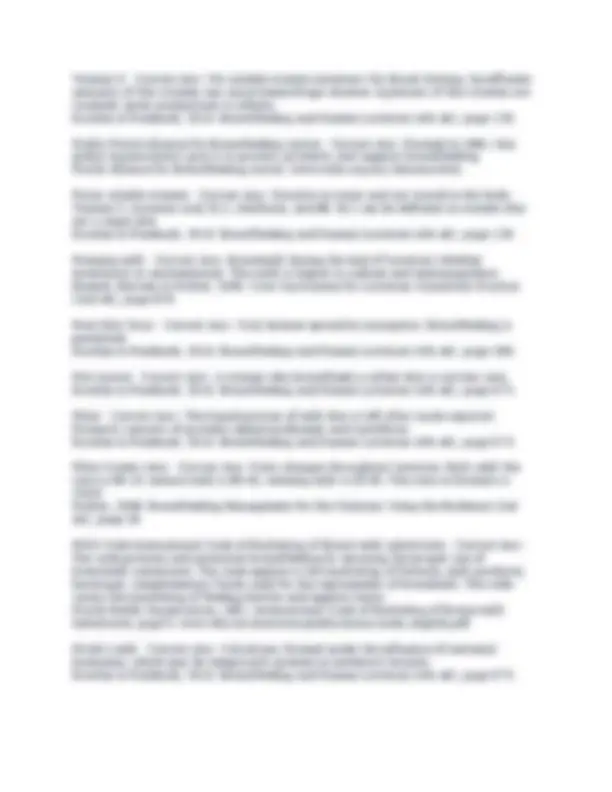



Study with the several resources on Docsity

Earn points by helping other students or get them with a premium plan


Prepare for your exams
Study with the several resources on Docsity

Earn points to download
Earn points by helping other students or get them with a premium plan
Community
Ask the community for help and clear up your study doubts
Discover the best universities in your country according to Docsity users
Free resources
Download our free guides on studying techniques, anxiety management strategies, and thesis advice from Docsity tutors
% of breastmilk that is carbohydrates Correct Ans:- Approximately 7% Wikipedia. en.wikipedia.org/wiki/Breast_milk. % of breastmilk that is fat Correct Ans:- Approximately 4% Hale and Hartman, 2007. Textbook of Human Lactation, page 50. % of breastmilk that is protein Correct Ans:- Approximately .8 - 1 % Mannel, Martens & Walker, 2008. Core Curriculum for Lactation Consultant Practice (2nd ed.), page 272. % of calories in breastmilk from carbohydrates Correct Ans:- Approximately 40% Hale and Hartman, 2007. Textbook of Human Lactation, page 69. % of calories in breastmilk from fat Correct Ans:- Approximately 50% Riordan & Wambach, 2010. Breastfeeding and Human Lactation (4th ed.), page 124. % of calories in breastmilk from protein Correct Ans:- Approximately 10%
Typology: Exams
1 / 41

This page cannot be seen from the preview
Don't miss anything!


































% of breastmilk that is carbohydrates Correct Ans:- Approximately 7% Wikipedia. en.wikipedia.org/wiki/Breast_milk. % of breastmilk that is fat Correct Ans:- Approximately 4% Hale and Hartman, 2007. Textbook of Human Lactation, page 50. % of breastmilk that is protein Correct Ans:- Approximately .8 - 1 % Mannel, Martens & Walker, 2008. Core Curriculum for Lactation Consultant Practice (2nd ed.), page 272. % of calories in breastmilk from carbohydrates Correct Ans:- Approximately 40% Hale and Hartman, 2007. Textbook of Human Lactation, page 69. % of calories in breastmilk from fat Correct Ans:- Approximately 50% Riordan & Wambach, 2010. Breastfeeding and Human Lactation (4th ed.), page 124. % of calories in breastmilk from protein Correct Ans:- Approximately 10% Mannel, Martens & Walker, 2008. Core Curriculum for Lactation Consultant Practice (2nd ed.), page 272. Acinus Correct Ans:- Any of the small sacs or alveoli that terminate the ducts and are lined with secretory cells. Merriam-Webster Medical Dictionary. Available online: http://www.merriam- webster.com/medical/acinus?show=0&t= Acrocyanosis Correct Ans:- Bluish discoloration of the hands and feet in the newborn; peripheral cyanosis. Should not persist beyond 24 hours after birth. Riordan & Wambach, 2010. Breastfeeding and Human Lactation (4th ed.), page 863. Active immunity Correct Ans:- Immunity conferred by the production of antibodies by one's own immune system. Riordan & Wambach, 2010. Breastfeeding and Human Lactation (4th ed.), page 868. Active transport Correct Ans:- Passage of drug into breastmilk assisted by components in breastmilk. Hale & Hartman, 2007. Textbook of Human Lactation, page 470. Acyclovir/Zovirax Correct Ans:- Antiviral used to treat herpes infections, L2. Riordan & Wambach, 2010. Breastfeeding and Human Lactation (4th ed.), page 177. Aerobic bacteria Correct Ans:- Bacteria requiring air for metabolic processes. The breast is colonized with this type of bacteria. Riordan & Wambach, 2010. Breastfeeding and Human Lactation (4th ed.), page 863. AGA Correct Ans:- Appropriate for Gestational Age. Having a birth weight between the 10th and 90th percentile on intrauterine growth charts. Riordan & Wambach, 2010. Breastfeeding and Human Lactation (4th ed.), page 671.
Alcohol and breastfeeding Correct Ans:- Alcohol can decrease milk supply. Breastfeeding must be interrupted for 1 hour per drink, or until mother is sober. Riordan & Wambach, 2010. Breastfeeding and Human Lactation (4th ed.), page 171 &
Aldomet/Methyldopa Correct Ans:- Antihypertensive, L2. Frequently used to treat hypertension during pregnancy. No concerns reported via breastmilk. Hale, 2010. Medications and Mother's Milk (14th ed.), page 667. Allergen Correct Ans:- A substance that causes an allergic response, such as foods, drugs, inhalants. Cow's milk is common source for infants. Riordan & Wambach, 2010. Breastfeeding and Human Lactation (4th ed.), page 863. Αlphalactalbumin Correct Ans:- A major protein found in human milk whey. Assists in processing lactose. Riordan & Wambach, 2010. Breastfeeding and Human Lactation (4th ed.), page 863. Alveolar ridge Correct Ans:- The ridges on the upper and lower jaw where infant's teeth will grow. Riordan & Wambach, 2010. Breastfeeding and Human Lactation (4th ed.), page 863. Alveolus, alveoli Correct Ans:- Secrete and store milk for let down. Surrounded by myoepithelial cells, contractile cells and connective tissue. Riordan & Wambach, 2010. Breastfeeding and Human Lactation (4th ed.), page 80. Amenorrhea Correct Ans:- A natural phase of infertility that takes place when a mother is exclusively breastfeeding. Menstruation has not returned. Riordan & Wambach, 2010. Breastfeeding and Human Lactation (4th ed.), page 707 &865. Amoxicillin Correct Ans:- Antibiotic, L2. Observe for change in intestinal flora, compatible. Riordan & Wambach, 2010. Breastfeeding and Human Lactation (4th ed.), page 177. Ampicillin Correct Ans:- Antibiotic, L1. Observe for change in intestinal flora, compatible. Riordan & Wambach, 2010. Breastfeeding and Human Lactation (4th ed.), page 177. Anaphylaxis Correct Ans:- Hypersensitivity (as to foreign proteins or drugs) resulting from sensitization following prior contact with the causative agent. Merriam-Webster Medical Dictionary. www.merriam-webster.com/medical/anaphylaxis. Anchor scar Correct Ans:- Surgical technique for breast reduction, slang. Ankyglossia Correct Ans:- A tongue tie. Characterized by a thick, short, or tight frenulum under the tongue. Can cause breastfeeding issues, such as a painful latch or inefficient milk transfer.
Riordan & Wambach, 2010. Breastfeeding and Human Lactation (4th ed.), page 92. Autonomy Correct Ans:- The capacity of a rational individual to make an informed, un-coerced decision. Wikipedia. en.wikipedia.org/wiki/Autonomy#Medicine. Average Correct Ans:- The middle value of a data set. Add all the numbers and divided by the amount of numbers in the set. Wikipedia. Available online: http://en.wikipedia.org/wiki/Average. Axilla Correct Ans:- Underarm. Breast tissue (the axillary tail) can sometimes extend into axilla. Riordan & Wambach, 2010. Breastfeeding and Human Lactation (4th ed.), page 863-864. B Cell Correct Ans:- Lymphocyte produced in bone marrow and peripheral lymphoid tissue; found in breastmilk. Attacks antigens. Riordan & Wambach, 2010. Breastfeeding and Human Lactation (4th ed.), page 864. β lactaglobin Correct Ans:- Major protein in bovine milk. Hale & Hartman, 2007. Textbook of Human Lactation, page 40. Back to sleep Correct Ans:- A campaign that significantly reduced SIDS. Babies are less prone to SIDS when sleeping on their back. Mannel, Martens & Walker, 2008. Core Curriculum for Lactation Consultant Practice (2nd ed.), page 632. Bactericidal Correct Ans:- Destroys bacteria. Merriam-Webster Medical Dictionary. www.merriam-webster.com/medical/bactericidal. Bacteriostatic Correct Ans:- Prevents the growth of bacteria. Riordan & Wambach, 2010. Breastfeeding and Human Lactation (4th ed.), page 864. Bactrim/Septra Correct Ans:- Sulfonamide antibiotic, L3. The mixture of trimethoprim and sulfamethoxazole. No concerns reported via breastmilk. Hale, 2010. Medications and Mother's Milk (14th ed.), page 249. BALT/GALT/MALT Correct Ans:- Bronchus/gut/mammary-associated immunocompetent lymphoid tissue. Intermammary pathway. IgA antibodies are transferred through breastmilk to the infant. Riordan & Wambach, 2010. Breastfeeding and Human Lactation (4th ed.), page 864. Basic research Correct Ans:- Research that generates knowledge for the sake of knowledge. Riordan & Wambach, 2010. Breastfeeding and Human Lactation (4th ed.), page 864. Bed-sharing Correct Ans:- Sharing adult bed with baby. Questioned safety in reduction of SIDS. Safe bed sharing has been shown to extend the duration of breastfeeding. Riordan & Wambach, 2010. Breastfeeding and Human Lactation (4th ed.), page 282-283.
Bellagio Consensus Conference Correct Ans:- Meeting to develop protocol for the Lactational Amenorrhea Method of birth control. 1988. Riordan & Wambach, 2010. Breastfeeding and Human Lactation (4th ed.), page 714-715. Beneficence Correct Ans:- The duty to do good. Riordan & Wambach, 2010. Breastfeeding and Human Lactation (4th ed.), page 31. BFHI Baby Friendly Hospital Initiative Correct Ans:- Initiative by UNICEF and WHO (1991) to support breastfeeding in hospitals and maternity centers. "The 10 Steps". Unicef. Baby-Friendly Hospital Initiative. Available online: http://www.unicef.org/programme/breastfeeding/baby.htm. Bioavailable Correct Ans:- The amount of a nutrient that is actually absorbed by the body. Nutrients found in breastmilk are easily absorbed by the infant's body. Riordan & Wambach, 2010. Breastfeeding and Human Lactation (4th ed.), page 864. Bisphenol A Correct Ans:- (BPA) organic compound found in plastics. Linked to disease in infants. Now banned. (BPA) organic compound found in plastics. Linked to disease in infants. Now banned. Bivariate Correct Ans:- Statistics derived from the analysis of the relationship between two variables. Riordan & Wambach, 2010. Breastfeeding and Human Lactation (4th ed.), page 864. Blessed thistle Correct Ans:- An herbal galactagogue. L3. Walker, 2009. Breastfeeding Management for the Clinician: Using the Evidence (2nd ed.), page 592. Bolus Correct Ans:- A quantity of medication given by IV, or a quantity of fluid (milk) given orally. Merriam-Webster Medical Dictionary. www.merriam-webster.com/medical/bolus. Bradycardia Correct Ans:- Relatively slow heart rate. Opposite of tachycardia. Merriam Webster Medical Dictionary. www.merriam-webster.com/medical/bradycardia. Breastfeeding dyad Correct Ans:- A breastfeeding mother and baby. Buccal pads Correct Ans:- Fat pads on the masseter muscles in an infant's cheeks giving them a plump cheeked appearance. Provide stability for the tongue during suckling. Riordan & Wambach, 2010. Breastfeeding and Human Lactation (4th ed.), page 864. Calories in breastmilk Correct Ans:- Mature milk has approximately 20 cal/oz. Mannel, Martens & Walker, 2008. Core Curriculum for Lactation Consultant Practice (2nd ed.), page 227. Candidiasis Correct Ans:- Fungal infection caused by Candida albicans; also called "thrush." Riordan & Wambach, 2010. Breastfeeding and Human Lactation (4th ed.), page 864.
Riordan & Wambach, 2010. Breastfeeding and Human Lactation (4th ed.), page 178. Hale, 2010, Medications in Mothers' Milk. p. 224. Claritin/Loratadine Correct Ans:- Long-acting antihistamine, L1. Observe for sedation, dry mouth, and tachycardia. Hale, 2010. Medications and Mother's Milk (14th ed.), page 617. CMV Cytomegalovirus Correct Ans:- Type of herpes virus found in human milk, genital tract, urine, and pharynx. Transmitted by close contact. Avoid pumping or breastfeeding in premature infants if mom has acute infection. Riordan & Wambach, 2010. Breastfeeding and Human Lactation (4th ed.), page 204. Colic Correct Ans:- Syndrome in early infancy characterized by episodic loud crying, apparent abdominal pain (legs drawn up and rigid abdomen) and irritability. Riordan & Wambach, 2010. Breastfeeding and Human Lactation (4th ed.), page 864-865. Colostrum Correct Ans:- First milk created during late pregnancy and early postpartum period. Has higher concentrations of immunoglobins, fat soluble vitamins and some minerals. Riordan & Wambach, 2010. Breastfeeding and Human Lactation (4th ed.), page 865. Comfrey Correct Ans:- An herbal poultice, L5. Is not considered safe due to alkaloids found in breastmilk after use. Hale, 2010. Medications and Mother's Milk (14th ed.), page 259. Conceptual framework Correct Ans:- Structure of interrelated concepts that may be generated inductively by qualitative research to provide a base for quantitative study. Riordan & Wambach, 2010. Breastfeeding and Human Lactation (4th ed.), page 865. Congenital infection Correct Ans:- Infection existing at birth that was acquired via placenta. Includes HIV and TORCH organisms. Riordan & Wambach, 2010. Breastfeeding and Human Lactation (4th ed.), page 865. Conjunctivitis Correct Ans:- Inflammation of the mucous membrane that lines the eyelid. Sometimes treated with fresh breastmilk. Riordan & Wambach, 2010. Breastfeeding and Human Lactation (4th ed.), page 865. Construct Correct Ans:- Higher order theoretical or empirical idea or phenomenon that has abstract meaning and requires multiple concepts to represent it more concretely. Riordan & Wambach, 2010. Breastfeeding and Human Lactation (4th ed.), page 865. Contraception Correct Ans:- Preventing conception. Hormonal pill, barrier methods, intrauterine device. Breastfeeding can provide contraceptive protection. Riordan & Wambach, 2010. Breastfeeding and Human Lactation (4th ed.), page 865. Cooper's ligaments Correct Ans:- Also know as the "suspensory ligaments." Attaches the skin of the breast to the chest wall. Riordan & Wambach, 2010. Breastfeeding and Human Lactation (4th ed.), page 82.
Cord blood Correct Ans:- Blood remaining in the umbilical cord after birth. May be saved for later stem cell transplantation. Riordan & Wambach, 2010. Breastfeeding and Human Lactation (4th ed.), page 865. Correlation coefficient Correct Ans:- Statistic that indicates the degree of relationship between two variables. The range in value is +1.00 to - 1.00; 0.0 indicates no relationship, +1.00 is a perfect positive relationship, and - 1.00 is a perfect inverse relationship. Riordan & Wambach, 2010. Breastfeeding and Human Lactation (4th ed.), page 865. Creamotcrit Correct Ans:- The amount of cream in a milk sample. The amount of cream (fat) varies from mother to mother, feeding to feeding, and throughout the course of lactation. Riordan & Wambach, 2010. Breastfeeding and Human Lactation (4th ed.), page 865. Cross-nursing Correct Ans:- Informal, short term wet nursing. Typically seen in the context of child care. Riordan & Wambach, 2010. Breastfeeding and Human Lactation (4th ed.), page 865. Cultural competency Correct Ans:- Ability to understand, communicate, and interact effectively with people from different cultures. Four components: Awareness of one's own cultural worldview; attitude towards cultural differences; knowledge of different cultural practices and worldviews; cross-cultural skills. Wikipedia. en.wikipedia.org/wiki/Cultural_Competency. Cultural relativism Correct Ans:- Acknowledging the variation in beliefs and actions given to the behaviors of different cultures. Riordan & Wambach, 2010. Breastfeeding and Human Lactation (4th ed.), page 865. Culture Correct Ans:- The values, beliefs, norms, and practices shared by a group of people that guide the thoughts and behaviors of that group. Riordan & Wambach, 2010. Breastfeeding and Human Lactation (4th ed.), page 865. Cyanotic/Cyanosis Correct Ans:- Bluish coloring due to low oxygen levels. Mannel, Martens & Walker, 2008. Core Curriculum for Lactation Consultant Practice (2nd ed.), page 296-296. Cytoprotective Correct Ans:- Protection from inflammation and death for cells. Riordan & Wambach, 2010. Breastfeeding and Human Lactation (4th ed.), page 854. De- Correct Ans:- Latin word meaning "of" or "from." Wikipedia. Available online: http://en.wikipedia.org/wiki/De. Deductive reasoning Correct Ans:- Process of reasoning from a general premise to the concrete and specific. Riordan & Wambach, 2010. Breastfeeding and Human Lactation (4th ed.), page 865. Deontology Correct Ans:- Approach to ethics that judges the morality of an action based on the action's adherence to rules. Described as duty or obligation, because rules 'binds you to your duty'.
Wikipedia. en.wikipedia.org/wiki/Diagnosis-related_group. Drip milk Correct Ans:- Milk that leaks from the opposite breast during a feeding. This milk is low in fat. Riordan & Wambach, 2010. Breastfeeding and Human Lactation (4th ed.), page 866. Ductules Correct Ans:- The small ducts in the mammary gland that transfer the milk from the alveoli to the lactiferous ducts. Riordan & Wambach, 2010. Breastfeeding and Human Lactation (4th ed.), page 866. Echinacea Correct Ans:- Herbal immunostimulant, L3. Known for stimulating immune system and wound healing. No concerns reported via breastmilk. Hale, 2010. Medications and Mother's Milk (14th ed.), page 348. Eczema Correct Ans:- A skin inflammation or rash. Riordan & Wambach, 2010. Breastfeeding and Human Lactation (4th ed.), page 866. Eminences of the pars villosa Correct Ans:- "Tiny swellings on the inner surfaces of the infant's lips that help the infant to retain a grasp on the breast during suckling." Riordan & Wambach, 2010. Breastfeeding and Human Lactation (4th ed.), page 866. EMM/EBM Correct Ans:- Expressed Mother's Milk/Expressed Breastmilk. Walker, 2009. Breastfeeding Management for the Clinician: Using the Evidence (2nd ed.), page 163. Endocrine control Correct Ans:- The point in lactation when milk supply is hormone driven. Milk will come in whether or not a mother is breastfeeding. Riordan & Wambach, 2010. Breastfeeding and Human Lactation (4th ed.), page 92. Enteromammary system Correct Ans:- Antigens enter maternal gut, pass to the lymph system where IgA specific antibodies are produced, then enter breastmilk. Hale and Hartman, 2007. Textbook of Human Lactation, page 200, 206 Enveloped virus Correct Ans:- Virus that cannot infect other cells without a coat (envelope). If the envelope is destroyed (e.g., by heat or soap and water) it is unable to produce infection. Ex. Cytomegalovirus and the human immunodeficiency virus. Riordan & Wambach, 2010. Breastfeeding and Human Lactation (4th ed.), page 866. Epidemiology Correct Ans:- Study of the frequency and distribution of disease and the factors causing that frequency and distribution. Riordan & Wambach, 2010. Breastfeeding and Human Lactation (4th ed.), page 866. Epidural Correct Ans:- Analgesia for childbirth. Anesthesia is placed in the epidural space just outside of the dura mater. Riordan & Wambach, 2010. Breastfeeding and Human Lactation (4th ed.), page 217. Epiglottis Correct Ans:- Cartilaginous structure of the larynx, just below the soft palate. When the infant swallows it closes the larynx maintaining passage of milk to the esophagus. Riordan & Wambach, 2010. Breastfeeding and Human Lactation (4th ed.), page 866.
Estrogen Correct Ans:- This hormone dramatically drops after birth allowing milk production to begin. Riordan & Wambach, 2010. Breastfeeding and Human Lactation (4th ed.), page 88. Ethical altruism Correct Ans:- Ethical doctrine that holds that individuals have a moral obligation to help, serve, or benefit others, if necessary at the sacrifice of self interest. Wikipedia. en.wikipedia.org/wiki/Ethical_altruism. Ethical egoism Correct Ans:- Ethical position that moral agents ought to do what is in their own self-interest. Wikipedia. en.wikipedia.org/wiki/Ethical_egoism. Ethnocentrism Correct Ans:- Assessing other cultures based on how one's own culture defines appropriate behavior. Riordan & Wambach, 2010. Breastfeeding and Human Lactation (4th ed.), page 866. Ethnography Correct Ans:- A research method that attempts to understand the beliefs, practices, and behaviors of the culture of study from the perspective of those living within the culture. Riordan & Wambach, 2010. Breastfeeding and Human Lactation (4th ed.), page 866. Exclusive Breastfeeding Correct Ans:- Feeding with only breastmilk, no supplements of water, glucose water, artificial breastmilk, or foods. Mannel, Martens & Walker, 2008. Core Curriculum for Lactation Consultant Practice (2nd ed.), page 296-297. Exercise and breastfeeding Correct Ans:- Moderate exercise is fine. Exercise to exhaustion can increase lactic acid levels in milk and baby may refuse to breastfeed. Riordan & Wambach, 2010. Breastfeeding and Human Lactation (4th ed.), page 501. Exocytosis Correct Ans:- A cell releases secretory vesicles as in production of protein and lactose in the alveoli. Merriam-Webster Medical Dictionary. www.merriam-webster.com/medical/exocytosis. Exogenous Correct Ans:- Derived from outside the body - such as iron supplements. Riordan & Wambach, 2010. Breastfeeding and Human Lactation (4th ed.), page 866. Expected daily weight gain in the first 3 months Correct Ans:- 15 - 30 grams or 1/2 to 1 ounce a day. Walker, 2009. Breastfeeding Management for the Clinician: Using the Evidence (2nd ed.), page 284. Expected daily weight gain in the first 3 months Correct Ans:- 15 - 30 grams or 1/2 to 1 ounce a day. Walker, 2009. Breastfeeding Management for the Clinician: Using the Evidence (2nd ed.), page 284.
Flexion Correct Ans:- Bending movement around a joint in a limb that decreases the angle between the bones of the limb at the joint. Opposite of extension. Merriam-Webster Medical Dictionary. www.merriam- webster.com/medical/flexion?show=0&t=1296702486. Flow rate Correct Ans:- Refers to the milk flow during milk ejection. Can also refer to the flow of a bottle nipple. When the milk flow is high the baby sucks slower and when the milk flow is low the baby sucks faster. Riordan & Wambach, 2010. Breastfeeding and Human Lactation (4th ed.), page 445 &
Foremilk Correct Ans:- The milk at the beginning of a breastfeeding. This milk has low fat content. Riordan & Wambach, 2010. Breastfeeding and Human Lactation (4th ed.), page 867. Fortification of breastmilk Correct Ans:- The process of adding extra nutrients to breastmilk for premature infants. These nutrients can be derived from human milk or cow's milk base. Walker, 2009. Breastfeeding Management for the Clinician: Using the Evidence (2nd ed.), page 46-47. Fourth intercostal nerve Correct Ans:- Essential for inervation of the nipple. Enters the areola at 5 o'clock position on the left breast and the 7 o'clock position on the right breast. Walker, 2009. Breastfeeding Management for the Clinician: Using the Evidence (2nd ed.), page 56. Frenotomy Correct Ans:- Release of tongue tie by clipping the lingual frenulum. Often preformed without anesthesia with few complications. Mannel, Martens & Walker, 2008. Core Curriculum for Lactation Consultant Practice (2nd ed.), page 389. Frenulectomy/frenuloplasty Correct Ans:- Surgical procedure to release a tongue tie. Used for more extensive tongue tie. Mannel, Martens & Walker, 2008. Core Curriculum for Lactation Consultant Practice (2nd ed.), page 389. Frenulum Correct Ans:- Membrane on the underside of the tongue that anchors it to the floor of the mouth. If short or tight it may restrict tongue extension and cause breastfeeding problems. Riordan & Wambach, 2010. Breastfeeding and Human Lactation (4th ed.), page 867. Gag reflex Correct Ans:- Reflex that protects the airway by causing a contraction in the back of the throat. Riordan & Wambach, 2010. Breastfeeding and Human Lactation (4th ed.), page 229 &
Galactocele Correct Ans:- A milk filled lacteal cyst. Most frequent lump found in a lactating breast. Riordan & Wambach, 2010. Breastfeeding and Human Lactation (4th ed.), page311. Galactogogue Correct Ans:- A food, herb or drug that is thought to increase milk supply in lactating women. Riordan & Wambach, 2010. Breastfeeding and Human Lactation (4th ed.), page 867. Galactopoiesis Correct Ans:- Maintaining lactation once lactogenesis has been established. Riordan & Wambach, 2010. Breastfeeding and Human Lactation (4th ed.), page 867. Galactorrhea Correct Ans:- Secretion of breastmilk in non-lactation women. Common among women who have previously been pregnant or breastfed.
Riordan & Wambach, 2010. Breastfeeding and Human Lactation (4th ed.), page 867. Hand expression Correct Ans:- The manual removal of milk. Mothers push hands back towards chest wall and then roll fingers towards the nipple. Riordan & Wambach, 2010. Breastfeeding and Human Lactation (4th ed.), page 241. Harlequin sign Correct Ans:- Harmless color change in a newborn in which the dependent side of the body is a deep color while the other side is pale. Riordan & Wambach, 2010. Breastfeeding and Human Lactation (4th ed.), page 867. HBIG Correct Ans:- Hepatitis B specific immunoglobulin. Infants who are born to mothers with hepatitis B should receive this immunization at birth. Mannel, Martens & Walker, 2008. Core Curriculum for Lactation Consultant Practice (2nd ed.), page 698. HBV Correct Ans:- Hepatitis B Virus. Riordan & Wambach, 2010. Breastfeeding and Human Lactation (4th ed.), page 205. HELLP syndrome Correct Ans:- H (intravascular hemolysis), EL (elevated liver enzymes; LP (low platelets). Develops as a result of pre-eclampsia in about 0.1% of women. Mannel, Martens & Walker, 2008. Core Curriculum for Lactation Consultant Practice (2nd ed.), page 610-611. Hematemesis Correct Ans:- Vomiting of blood. The bleeding may be from the infant's upper gastrointestinal (GI) tract or a crack in the mother's nipple. Riordan & Wambach, 2010. Breastfeeding and Human Lactation (4th ed.), page 867. Hepatitis A Correct Ans:- Acute viral infection of the liver usually transmitted through food and water-borne routes. The newborn can be infected by vertical transmission from the mother. Baby and mother should be given gamma globulin. Breastfeeding can proceed as normal. Mannel, Martens & Walker, 2008. Core Curriculum for Lactation Consultant Practice (2nd ed.), page 697. Hepatitis B Correct Ans:- Acute viral infection of the liver. It is safe for baby to breastfeed from infected mother, if baby receives a hepatitis vaccine with 12 hours after birth. Riordan & Wambach, 2010. Breastfeeding and Human Lactation (4th ed.), page 205. Hepatitis C Correct Ans:- Chronic viral infection of the liver. Breastfeeding is allowed if mother's titers are not high. Riordan & Wambach, 2010. Breastfeeding and Human Lactation (4th ed.), page 205-206. Hepatitis D Correct Ans:- Viral infection of the liver, usually a co-infection with Hepatitis B. Once immunization has begun breastfeeding can begin. Mannel, Martens & Walker, 2008. Core Curriculum for Lactation Consultant Practice (2nd ed.), page 698.
Hepatitis E Correct Ans:- Viral infection of the liver that is self-limited and is not chronic. It is typically association with water contamination. Breastfeeding is considered safe. Mannel, Martens & Walker, 2008. Core Curriculum for Lactation Consultant Practice (2nd ed.), page 698. Hepatitis G Correct Ans:- Viral infection of the liver is associated with blood transfusions and has not been proven to transmit through breastmilk. Mannel, Martens & Walker, 2008. Core Curriculum for Lactation Consultant Practice (2nd ed.), page 698. Heroine Correct Ans:- Narcotic analgesic, L5. Not recommended for breastfeeding. Infant should be observed for sedation, tremors, vomiting, restlessness, and poor feeding. Hale, 2010. Medications and Mother's Milk (14th ed.), page 500. HSV Herpes Simplex Virus Correct Ans:- Sexually transmitted disease. Type 1 is infection of the genitalia. Type 2 occurs in the mouth region. However, lesions can occur on any place of the body including the breasts. Infants should not come in contact with active lesions. Good hand washing should be encouraged. Riordan & Wambach, 2010. Breastfeeding and Human Lactation (4th ed.), page 201-202. High Temperature Short Time Pasteurization Correct Ans:- Method of pasteurization of breastmilk to preserve nutrients. www.britannica.com/EBchecked/topic/265421/high-temperature-short-time-method Hind-milk Correct Ans:- The milk at the end of a breastfeeding. This milk has a higher fat content. Riordan & Wambach, 2010. Breastfeeding and Human Lactation (4th ed.), page 867. Human Immunodeficiency Virus Acquired Immunodeficiency Syndrome HIV/AIDS Correct Ans:- Sexually transmitted disease. Antiretroviral drugs are helpful in prevention of it's spread to infant during pregnancy. In the U.S. it is recommended that women do not breastfeed. In developing countries exclusive breastfeeding is recommended. Riordan & Wambach, 2010. Breastfeeding and Human Lactation (4th ed.), page 198-199. Holder pasteurization Correct Ans:- A pasteurization process in which the milk is heated to 62.5o Celsius for 30 minutes, and then rapidly cooled in ice water. Riordan & Wambach, 2010. Breastfeeding and Human Lactation (4th ed.), page 482. Horizontal axis Correct Ans:- The "Y" axis in a graph The X-axis and Y-asix remembered. www.gradeamathhelp.com/x-axis-and-y-axis.html Horizontal transmission Correct Ans:- Transmission of pathogens through direct contact. Riordan & Wambach, 2010. Breastfeeding and Human Lactation (4th ed.), page 867.
Hypoglycemia Correct Ans:- Low blood glucose levels. Breastfed infants tend to have lower glucose levels than formula fed infants. Riordan & Wambach, 2010. Breastfeeding and Human Lactation (4th ed.), page 233. Hypothalamus Correct Ans:- Links the nervous system to the endocrine system via the pituitary gland. Secrets the prolactin-inhibiting factor (dopamine). Mannel, Martens & Walker, 2008. Core Curriculum for Lactation Consultant Practice (2nd ed.), page 225. Riordan & Wambach, 2010. Breastfeeding and Human Lactation (4th ed.), page 88. Hypoxia Correct Ans:- Low blood oxygen causing tachycardia, hypertension, peripheral, vasoconstriction, dizziness, and mental confusion. Riordan & Wambach, 2010. Breastfeeding and Human Lactation (4th ed.), page 868. IDM Correct Ans:- Infant of Diabetic Mother Walker, 2009. Breastfeeding Management for the Clinician: Using the Evidence (2nd ed.), page 227-241. IgE mediated allergy Correct Ans:- Allergic reaction to food causing immediate, systemic reaction; can sometimes be severe. Wikipedia. Available online: http://en.wikipedia.org/wiki/Food_allergy. Immunoglobulin Correct Ans:- Proteins produced by plasma cells to respond to a immunogen. The 5 different types include: IgG, IgA, IgM, IgE, and IgD. Riordan & Wambach, 2010. Breastfeeding and Human Lactation (4th ed.), page 142. Incidence Correct Ans:- the relative frequency of occurrence of something Riordan & Wambach, 2010. Breastfeeding and Human Lactation (4th ed.), page 868. Incubation period Correct Ans:- Period between exposure to infectious pathogens and the first signs of illness. Riordan & Wambach, 2010. Breastfeeding and Human Lactation (4th ed.), page 868. Independent variable Correct Ans:- Experimental (treatment) variable that is manipulated by the investigator to influence the dependent (outcome) variable. Riordan & Wambach, 2010. Breastfeeding and Human Lactation (4th ed.), page 868. Induced lactation Correct Ans:- The process of stimulating milk production in a woman who has not been pregnant for the current child. Riordan & Wambach, 2010. Breastfeeding and Human Lactation (4th ed.), page 869. Inductive reasoning Correct Ans:- Process of reasoning from specific observations or abstractions to a general premise. Riordan & Wambach, 2010. Breastfeeding and Human Lactation (4th ed.), page 869. Inferior pedicle technique Correct Ans:- Breast reduction surgical technique. Mannel, Martens & Walker, 2008. Core Curriculum for Lactation Consultant Practice (2nd ed.), page 654.
Informed consent Correct Ans:- A patient has been given full information and offered appropriate options. Wikipedia. en.wikipedia.org/wiki/Informed_consent. Inframammary incision Correct Ans:- Technique used in breast augmentation where the incision is made in the fold under the breast and the implant is placed under the breast tissue. Riordan & Wambach, 2010. Breastfeeding and Human Lactation (4th ed.), page 309. Insulin/humulin Correct Ans:- Hormone that regulates carbohydrate and fats. L1, no concerns reported breastmilk. Insulin is too large a molecule to be secreted into breastmilk. Hale, 2010. Medications and Mother's Milk (14th ed.), page 537. Internal validity Correct Ans:- Extent to which manipulation of the independent variable makes a significant difference on the dependent variable, or the extent to which the independent variable, rather than extraneous variables, has caused the change in the dependent variables. Riordan & Wambach, 2010. Breastfeeding and Human Lactation (4th ed.), page 869. Intracellular Correct Ans:- Occurring within cells. For example, viruses live within cells as part of their reproductive period. Riordan & Wambach, 2010. Breastfeeding and Human Lactation (4th ed.), page 869. Intrauterine Correct Ans:- Within the uterus; in utero. Riordan & Wambach, 2010. Breastfeeding and Human Lactation (4th ed.), page 869. Intrauterine growth rate Correct Ans:- Normal rate of weight gain of a fetus. It is considered by many to be the ideal growth rate for premature infants. Riordan & Wambach, 2010. Breastfeeding and Human Lactation (4th ed.), page 869. Inverted nipple Correct Ans:- Nipple below the skin line. Umbilicated nipple can be pulled out or everted, while an invaginated nipple cannot be everted. Occurs in 3 percent of women. Involution Correct Ans:- When breasts return to a non-lactating state. Riordan & Wambach, 2010. Breastfeeding and Human Lactation (4th ed.), page 869. Isoniazid Correct Ans:- Anti-tuberculosis agent, L3. No concerns reported via milk but infant should be monitored for toxicity. Hale, 2010. Medications and Mother's Milk (14th ed.), page 551. IUD Intrauterine device Correct Ans:- A birth control device inserted into the uterus. Non-hormonal types have been shown to have no effect on lactation. Riordan & Wambach, 2010. Breastfeeding and Human Lactation (4th ed.), page 725-726. IUGR Correct Ans:- Intrauterine Growth Restriction. An infant with slower than expected intrauterine growth. Riordan & Wambach, 2010. Breastfeeding and Human Lactation (4th ed.), page 671.